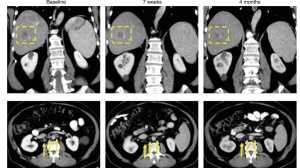这几年,肿瘤治疗领域有多项突破性进展,诞生了多个明星“抗癌家族”,比如大家熟知的PD-1/PD-L1家族(多种癌症)、EGFR家族(肺癌)、ALK家族(肺癌)等,无数癌症患者获得了“新生”。
除此之外,还有一个抗癌新星正在冉冉升起——PARP家族,尤其是最近半年,多个重磅进展相继公布:
○ 2019年9月,欧洲临床肿瘤学年会(ESMO)期间,四大PARP抑制剂公布振奋人心的临床数据,都显示了对无需考虑BRCA突变状态卵巢癌患者的优秀疗效;
○ 2019年10月,尼拉帕利获得美国FDA的新批文,用于治疗至少3线失败的晚期同源重组修复缺陷的卵巢癌患者;
○ 2019年12月,尼拉帕利在国内获批,用于复发卵巢癌的维持治疗,这是继奥拉帕利之后国内第二个获批的PARP抑制剂;
○ 2019年12月,奥拉帕利获得美国FDA的新批文,单药一线维持治疗携带遗传性BRCA胚系突变且含铂治疗方案至少16周内疾病未进展的转移性胰腺癌患者。
近期,多个国产PARP抑制剂,纷纷获得国家药监局的临床试验批文,在国内开展了针对卵巢癌、乳腺癌、前列腺癌、胰腺癌等众多实体瘤的临床试验……
鉴于此,咚咚给广大癌种患者总结一下国内外PARP抑制剂的最新进展,也期待这些新药能给更多患者带来希望。
① 奥拉帕利(Olaparib):国内上市,进医保
奥拉帕利是阿斯利康公司研发,世界上第一款上市的PARP抑制剂,自2014年底在美国获批上市后,目前已涵盖了BRCA突变卵巢癌患者的一二线治疗和难治复发乳腺癌二三线治疗与BRCA突变胰腺癌的一线治疗。
目前,奥拉帕利已经于2018年8月22日在国内上市,获批的适应症包括:无论gBRCA突变状态,复发性卵巢癌二线铂类化疗后维持治疗;BRCA突变晚期卵巢癌的一线维持治疗。
○ 精准狙击,且看奥拉帕利如何利落斩杀癌细胞,6登国际顶尖杂志
瑞卡帕利是Clovis 研发的全球第二个上市的PARP抑制剂,但是却是全球第一个被加速批准用于卵巢癌三线治疗的PARP抑制剂。

尼拉帕利是Tesaro和GSK联合开发的,全球第三个上市的PARP抑制剂,虽然比奥拉帕利晚3年在美国上市,但是作为PARP抑制剂中的一匹黑马进展迅速,也创造了两个治疗领域的第一:
○ 第一个批准用于无论是否有gBRCA突变,治复发性卵巢癌二线铂类化疗后维持治疗。
○ 第一个批准用于同源重组缺陷HRD阳性的卵巢癌患者四线及以上治疗。
再鼎制药已经将尼拉帕利引进中国,正在进行小细胞肺癌和卵巢癌两个领域的临床试验,2018年12月向中国药审中心递交了上市申请,2019年12月27号,尼拉帕利获得药监局的批准,正式登陆中国。目前,患者援助项目也已经出台,亲民价格。
他帕唑帕利是辉瑞开发的全球第四个上市的PARP抑制剂,首次批准的适应症为gBRCA突变的乳腺癌,具体临床数据如下:

除了已上市“各显神通”的PARP抑制剂外,还有未上市的新面孔值得期待。
雅培公司的维利帕利可能会是全球第五个上市的PARP抑制剂,在2019年的ESMO会议上发表结果发布了卵巢癌和乳腺癌维持治疗的结果。

氟唑帕利是恒瑞医药研发的PARP抑制剂,并已经被中国药审中心纳入上市药物优先审评,猜测申报上市的适应症极有可能为复发性卵巢癌患者,该适应症在国内已经推进到III期临床阶段。也就是说,这也许会是中国第一个上市的中国自主原研的PARP抑制剂。
氟唑帕利在2019年的ESMO会议上也发布了优异的试验结果:在BRCA1/2突变的铂敏感卵巢癌中疗效和安全性探索的多中心Ib期研究,ORR高达55.8%,且截至数据发布日期,尚未达到中位PFS和OS,这意味着有持续的生存优势。
Pamiparib的研发进展也备受关注,因为这是创造中国新药首次在美国成功上市记录的公司,百济神州研发的PARP抑制剂,目前在包括中国的国家地区开展了卵巢癌、前列腺癌和胃癌的的关键性试验。
在2019年的ESMO会议上公布了Pamiparib单药,和与低剂量替莫唑胺联合用于实体瘤患者安全性和剂量探索的I期临床试验结果,显示对多种实体瘤患者均安全且达到一定程度的疾病缓解。
短短5年时间内,PARP抑制剂已经成为卵巢癌、乳腺癌的重要治疗方法之一,同时在包括癌王胰腺癌等癌种中显示出了优异的临床数据,对患者来说,又多了一份希望。
[1] Domchek, Susan M., et al. “Efficacy and Safety ofOlaparib Monotherapy in Germline BRCA1/2 Mutation Carriers with AdvancedOvarian Cancer and Three or More Lines of Prior Therapy.” Gynecologic Oncology,vol. 140, no. 2, 2016, pp. 199–203.
[2] Pujade-Lauraine, Eric, et al. “Olaparib Tabletsas Maintenance Therapy in Patients with Platinum-Sensitive, Relapsed OvarianCancer and a BRCA1/2 Mutation (SOLO2/ENGOT-Ov21): A Double-Blind, Randomised,Placebo-Controlled, Phase 3 Trial.” Lancet Oncology, vol. 18, no.9, 2017, pp. 1274–1284.
[3] Moore, Kathleen, et al. “Maintenance Olaparibin Patients With Newly Diagnosed Advanced Ovarian Cancer.” Obstetrical& Gynecological Survey, vol. 74, no. 2, 2019, pp. 86–87.
[4] LBA3 – Coleman RL, Fleming GF, Brady MF, etal. VELIA/GOG-3005: Integration of veliparib (V) with front-line chemotherapyand maintenance in women with high-grade serous carcinoma of ovarian, fallopiantube, or primary peritoneal origin (HGSC).
[5] Ledermann J, Harter P, Gourley M, et al. Olaparib maintenance therapy inplatinum-sensitive relapsed ovarian cancer. N Engl J Med 2012;366:1382-1392.
[6] Moore, Kathleen, et al. “Maintenance Olaparibin Patients With Newly Diagnosed Advanced Ovarian Cancer.” Obstetrical& Gynecological Survey, vol. 74, no. 2, 2019, pp. 86–87.
[7] Moore, Kathleen N., et al. “NiraparibMonotherapy for Late-Line Treatment of Ovarian Cancer (QUADRA): A Multicentre,Open-Label, Single-Arm, Phase 2 Trial.” Lancet Oncology, vol. 20,no. 5, 2019, pp. 636–648.
[8] Coleman, Robert L., et al. “Rucaparib MaintenanceTreatment for Recurrent Ovarian Carcinoma after Response to Platinum Therapy(ARIEL3): A Randomised, Double-Blind, Placebo-Controlled, Phase 3 Trial.” TheLancet, vol. 390, no. 10106, 2017, pp. 1949–1961.
[9] Litton, Jennifer K., et al. “Talazoparib inPatients with Advanced Breast Cancer and a Germline BRCA Mutation.” TheNew England Journal of Medicine, vol. 379, no. 8, 2018, pp. 753–763.
[10] LBA9 – Diéras VC, Han HS, Kaufman B, etal. Phase 3 study of veliparib with carboplatin and paclitaxel inHER2-negative advanced/metastatic gBRCA-associated breast cancer.
[11] LBA3 – Coleman RL, Fleming GF, Brady MF, etal. VELIA/GOG-3005: Integration of veliparib (V) with front-linechemotherapy and maintenance in women with high-grade serous carcinoma ofovarian, fallopian tube, or primary peritoneal origin (HGSC).
[12] Voskoboynik, M., et al. “452PDSafety, AntitumorActivity, and Pharmacokinetics (PK) of Pamiparib (BGB-290), a PARP1/2Inhibitor, in Patients (Pts) with Advanced Solid Tumours: Updated Phase IDose-Escalation/Expansion Results.” Annals of Oncology, vol. 30,2019.
[13] Stradella, A., et al. “451PDUpdated Results of the PARP1/2 InhibitorPamiparib in Combination with Low-Dose (Ld) Temozolomide (TMZ) in Patients(Pts) with Locally Advanced or Metastatic Solid Tumours.” Annals ofOncology, vol. 30, 2019.
[14] N Li, L Wu, Y Zhang, J Liu, Q Zhou, J Zhu, RYin, L Wang, G Li, X Wu, H Pan, S Yao, Q Wu, K Gu, H Zhang, X Wan, R An, J Zou,Q Wang, 1000P
Efficacy and safety of oral poly (ADP-ribose) polymerase inhibitor fluzoparibin patients with BRCA1/2 mutations and platinum sensitive recurrent ovariancancer, Annals of Oncology, Volume 30, Issue Supplement_5, October 2019













-1.jpg-pd13)
-1-scaled.jpg-pd13)
.jpg-pd13)













 X
X